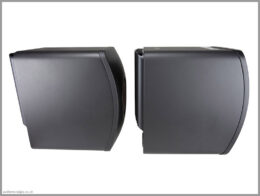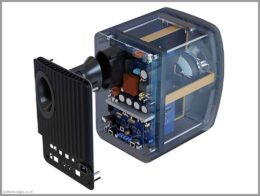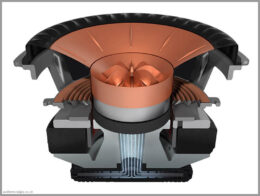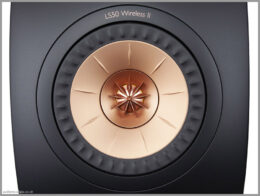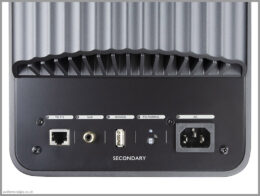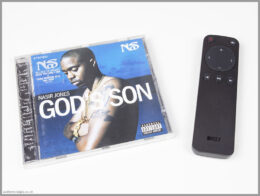TABLE OF CONTENTS
MY STORY
I was intimately familiar with the KEF LS50 Wireless II as my good friend has been using them as his main speakers for over two years. I’ve heard them in his quite absorbent room on numerous occasions and I always liked what I was hearing. When he decided to purchased the KEF LS60 Wireless, he lent me his LS50 so I could experience them in my own environment for a longer period of time.
SPEAKER INFO
Design
KEF LS50 Wireless II belong to the new generation of speakers designed for people who desire compact, all-in-one stylish sound systems. They bridge the gap between the hardcore audiophiles with separate components, and people who play their music from Bluetooth speakers. Normally these two words would not cross each other – former would be full of high quality and expensive components, whereas latter would be driven by convenience and connectivity options, and would likely be at the lower end of the pricing scale. This is where KEF comes in with their Wireless speaker line-up. They offer fantastic connectivity and convenience options combined with very high sound quality but at a price significantly higher than most people would pay for a Bluetooth speaker.
Connectivity
KEF LS50 speakers are active, which means that each driver has a separate amplifier. The signal division (crossover) is done in the digital domain. The speakers are also wireless, where the audio signal could be sent to them without any cables (Bluetooth, Wi-Fi). They will of course need to be connected to the mains power supply, so they are not truly “wireless”. They also offer other non-wireless connectivity options, such as analogue 3.5mm Jack AUX input, and digital inputs such as TOSLINK, Coaxial, and standard HDMI (for connections with AV equipment). If one is interested in extending their bass, they also offer analogue RCA subwoofer outputs (one per speaker).
Because KEF LS50 Wireless II have a built in Digital Signal Processor (DSP), you can change the character of their sound from you mobile phone, using the KEF app which is very convenient. Having this feature means that in order for the speakers being able to accept analogue signals, they must have a built-in analog-to-digital convertor (ADC). Moreover, in order for them to send an analogue signal to speaker amplifiers, they also have a built-in digital-to-analog convertor (DAC). Consequently, if you were to feed the speakers with the analogue signal, it will first get converted to a digital signal, processed and then converted back into an analogue signal. This should not be audible, but I would probably feel more comfortable feeding the speakers with digital signals, to avoid additional ADC conversion.
KEF LS50 Wireless II also include a streamer, compatible with most popular streaming services (Spotify, Tidal, Amazon Music, Qobuz, Deezer, QQ Music, Internet Radio, and Podcast). Thus, if you are a minimalist and don’t want any HiFi equipment around, you can just have the speakers and stream your music through them. Two speakers, a mobile phone and two power cables – viola! Simple as that.
Technology
Enough about the features though, let’s talks about the KEF LS50 drivers… on the front baffle we have a 130mm coaxial driver, with 25mm aluminium dome tweeter and 130MM aluminium cone midrange. KEF refers to it as 12th generation Uni-Q driver array with their Metamaterial Absorption Technology. KEF claims that thanks to this technology 99% of the unwanted sound from the rear of the tweeter is absorbed. According to their studies, traditional methods of absorption (such as foam, felt, wool, etc) are claimed to only absorb 60% of the unwanted sound from the rear of the tweeter. I have no way to verify this, however, if this claim is indeed correct, then the percentage improvement is very impressive. For those not familiar the “metamaterials” term – metamaterials don’t rely on natural absorptive properties of the material, instead they use a cleverly designed structure and shape to achieve the desired outcome. In the case of KEF LS50 tweeter, the component responsible for absorbing rear soundwaves looks like a maze.
With the aid of computer simulations, metamaterials have been gaining a lot of popularity in recent years in various industries. HiFi is not an exemption, and KEF LS50 Wireless II are a great example of that!
To sum up, KEF LS50 Wireless II speakers are packed with technology and futuristic designs. If you want a high quality sound in a compact format – these should definitely be high on your list.
KEF LS50 WIRELESS II Specs
| Frequency Response: | 45 – 28,000Hz (+/- 3dB) |
| Sensitivity: | N/A |
| Impedance: | N/A |
| Built-In Amplifier: | LF-MF: Class D 280W, HF: Class AB 100W |
| High & Mid-Low Frequency Driver: | Uni-Q 130mm (5.25″) Coaxial Driver with 25mm (1″) HF Aluminium Dome with Metamaterial Absorption Technology and 130mm (5.25″) MF-LF Aluminium Cone |
| Crossover Frequencies: | Unknown |
| Enclosure Type: | Bass Reflex |
| Enclosure Dimensions (HxWxD): | 305x200x311 mm (12×7.9×12.2″) |
| Weight: | 10kg (each speaker) |
| Production Years: | 2020 – Current |
| Price When Launched: | £2,499 for a pair |
LOOK & FEEL OF KEF LS50 WIRELESS II SPEAKERS
I have conflicting feelings about KEF LS50 styling. On one side, I really like the colour variations, sleek front baffle and the attention to details that KEF pays with their designs. On the other hand, the proportions of the speakers seem a little off to me. They seem too small for a medium speaker and too large for a small speaker. They look chunky on the stands and too overwhelming on most computer desks. Again, this is just my subjective opinion. I think my wife would be over the moon if we had these KEF LS50 in our living room instead of speakers that I normally prefer (large and heavy ;).
The cabinets of the KEF LS50 Wireless II seem very inert and well made. They give an impression of good quality, which is further enhanced by how heavy they feel for their size (just short of 10kg each speaker). The matt paint looks great but it’s a fingerprint magnet and its challenging to clean. The orange drivers and orange bass reflex ports on the back nicely contrast with the black matt of the enclosure. As the reviewed pair did not belong to me, I did not dare to ‘open them up’ to inspect the internals. Nonetheless, the visible parts of the drivers look the part. The only thing that does not impress is the remote control. It is functional and there is nothing wrong with it, however, it just does not look and feel as attractive as the speakers.
Overall, KEF L50 Wireless II are very high quality loudspeakers.
SOUND OF KEF LS50 SPEAKERS
First Impressions
Before I connected the KEF L50 Wireless II speakers, I was listening to a set of Harbeth P3ESR 40th Anniversary Edition. I took this opportunity to compare them side by side. First impressions after connecting KEFs was that they sound more effortless and more impactful. On the other hand P3s sounded more open and had deeper bass, but strangely, not as easy to listen to! The bass impressions puzzled me as the P3ESRs definitely don’t look like speakers capable of very deep bass. I got my measuring gear out and measured the room with with both speaker pairs to see how they interacted with it. It turned out that in my room Harbeths are relatively flat in the bass with a gentle roll-off that reaches to 25 Hz at -10dB. KEFs on the other hand have a steep drop below 45Hz and reach 25Hz at -18dB. They also activated my room mode at 53Hz a lot more than Harbeths. This is very similar (but to lesser extent) to what I experienced with the KEF LS60 Wireless. Whereas that bass problem made the LS60 Wireless frustrating to listen to, it wasn’t as pronounced on the LS50 Wireless II, and in a way, compensated for the lack of the lowest bass. Nevertheless, I went into the KEF app and changed the bass setting from Standard to Less, which in my room provided me with the better overall balance.
Satisfied with the outcomes, I have moved the Harbeth P3ESR out of the way, and concentrated on listening to the KEF L50 Wireless II.
Bass
These relatively small speakers are definitely fun to listen to and their bass punches above its weight. It has more impact and it sounds more effortless than one would expect form the speakers of this size. Axel F by Harold Faltermeyer sounded very impressive, providing I did not go too crazy with the volume control. It felt that beyond certain volume level there was some digital trickery going on to protect the bass driver. I could hear that as I was turning up the volume, all frequencies were going up with an exception of the lowest bass – a neat trick to prevent speaker damage. Bear in mind that these are not disco speakers. They may have a built-in protection but they definitely do not sound comfortable at high volume levels. Thus, if you you have a relatively large room or you frequently play loud, these will probably not be sufficient for you. However, for normal listening levels, KEF L50 Wireless II do a very good job of fooling you that you are listening to much bigger speakers. Just note that if you’ve heard deep bass before, you will know that something is missing. On songs such as I Want You Back by Lake Street Drive, double bass does not sound as meaty and rich as what I’m accustomed to, but as soon as the vocals start, you forget about it because they sound so sublime…
Midrange, Treble, and Soundstage
This leads me nicely to midrange and treble, which are absolutely fantastic. Very smooth and sweet sounding and not fatiguing at all. During the review process I was listening to various music genres, and every handful of tracks I was catching myself thinking “gosh, this voice sounds great”. One of the songs that caught my attention was Man In The Mirror by Michael Jackson, with reach and warm vocals. It is worth noting that KEF L50 Wireless II seem warmer and sweeter sounding that their bigger brothers, KEF LS60 Wireless, and I very much prefer that. KEF LS50 remind me a lot of Harbeth speakers with their ability to present details without sounding fatiguing. For instance, I really like the So Caught Up track by the Teskey Brothers from their Live at The Forum album. Unfortunately the voice of the main vocalist is distorted (as if he was too close to the microphone) and that bothers me a lot on very revealing speakers. I can still hear it on the LS50s, but is just a lot more bearable and it does not distract me from enjoying the music. This combined with all other qualities makes the KEF L50 Wireless II very involving to listen to. For instance, albums such as Busted Stuff by Dave Matthews Band sound quite flat and not very engaging on most systems, whereas on the LS50s, it’s actually not a bad listen. On the other hand, on well recorded music, I sometimes feel that little KEFs are missing some spark and air. Don’t get me wrong,
KEF L50 Wireless II speakers give you a good number of clues about where the recoding took place, but definitely not to the level I’m used to with Magnepan 1.7i. The soundstage is very well defined with decent depth – I really like how this speakers image. On Trenchtown Rock by Bob Marley & The Wailers the crowd cheering is nicely separated from the band playing and the layering is very good indeed.
I’d like to think that KEF LS50 is what the LS3/5a would be if these were designed 50 years later. If this has not been clear from my review above – I really like like these speakers! As a matter of fact, in my room, I much prefer their sound to the KEF LS60 Wireless.
CONCLUSION
KEF LS50 Wireless II are truly all-in-one next generation speakers. They are very smooth sounding speakers with impactful bass and sublime midrange. Never fatiguing – can be enjoyed for hours. If you are looking for a compact and rich in features all round speakers – look no further!
| Balance of Sound: | |
| Neutrality of Tone: | |
| Transparency: | |
| Soundstage: | |
| Attack: | |
| Engagement: | |
| Total Score: |
SONGS MENTIONED IN THIS REVIEW
Bob Marley & The Wailers – Trenchtown Rock (Live)
Dave Matthews Band – Busted Stuff
Harold Faltermeyer – Axel F
Lake Street Drive – I Want You Back
Michael Jackson – Man In The Mirror
Teskey Brothers – So Caught Up (Live)
Reviewed: October 2022 | Published: December 2022





